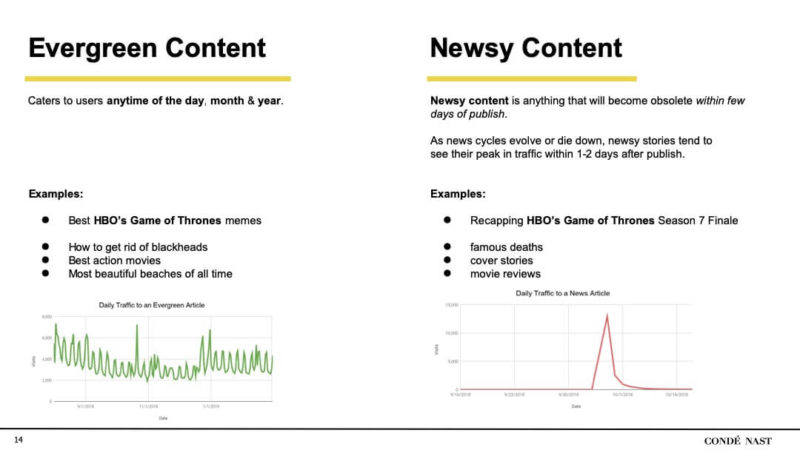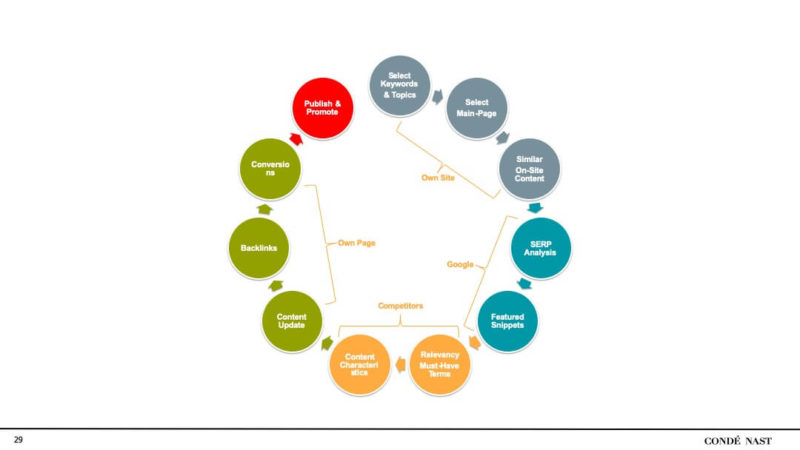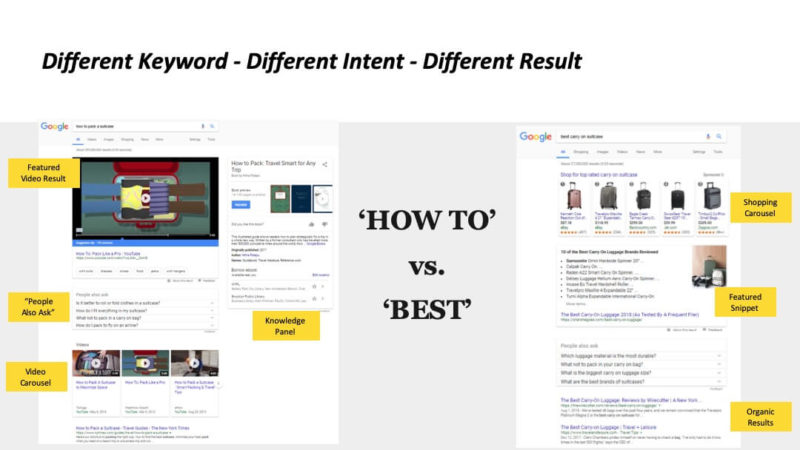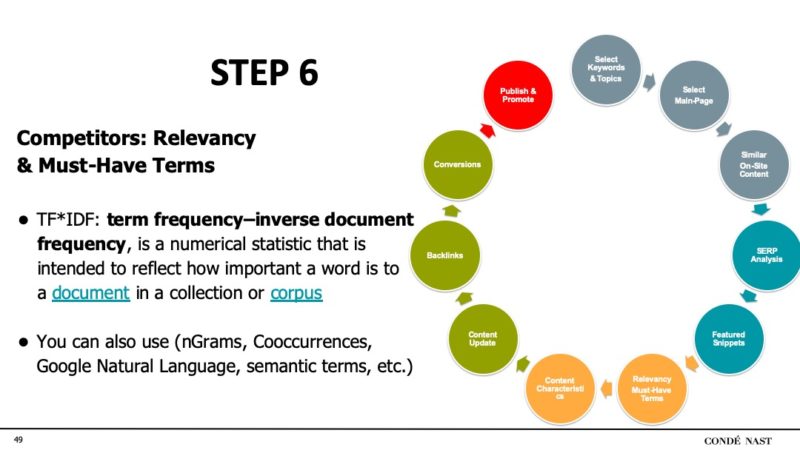NEW YORK — Creating content can do wonders for your brand, but not if it goes unseen. A staggering 90% of the content in existence today has been created within the last two years, yet 91% of content gets no traffic from Google, said John Shehata, vice president of audience development strategy for Conde Nast, at SMX East in New York.
Investing in new content isn’t always the right choice for better content marketing. Sometimes, brands are better served by leveraging assets they already have or putting a fresh spin on an existing topic.
Old content, new traffic
“For the first 100 articles that we optimized, we saw a 210% increase in search traffic and our keyword coverage for that content increased by 900%,” said Shehata, explaining the results of his “Pinetree Initiative,” an experiment aimed at expanding existing content and merging underperforming content to increase organic visibility. “Once we refreshed the content, the traffic started increasing immediately. It went from like 100 visits to like 15,000–20,000 visits.”
(Don’t Miss SMX West in San Jose!)
“You’re reporting news or something trending, the traffic spikes out for like 24 to 48 hours, and it’s done, right?” Shehata said. “Versus evergreen content — that content can bring you traffic for a year plus.”

Content is considered evergreen if it remains relevant long after its publication. Tutorials, FAQ’s, in-depth guides, expert interviews and case studies are all examples of evergreen content.
In addition to providing more sustainable traffic to your site, evergreen content also insulates publishers from slow news cycles and can drive prospects to the top of the funnel, Shehata said.
However, news content can still be valuable and publishers should aim for a 60/40 split of both content types, in either direction, said Shehata. For example, if you’re a news publisher, 60% news and 40% evergreen content is more likely to resonate with your audience, as where an industry-based publication might publish 60% evergreen and 40% news content.
Refreshing evergreen content, step by step
Conde Nast’s search traffic and ranking keyword growth was made possible by an 11-step process that Shehata developed specifically for content refreshes. It begins with examining your own site, analyzing the search results pages for your target keywords, evaluating competing content, optimizing on-page content and publishing and promotion, as illustrated below.

1. Assess your existing content. Brands can begin their evergreen content refreshes by either selecting a topic and keywords or selecting a main page to refresh, said Shehata.
Whichever starting point you choose, the next thing you’ll need to do is identify all of your own competing pages that rank for the target keywords. Shehata does this by combining Google Sheets with various keyword research tool APIs to consolidate the URLs and relevant metrics into one place, giving him a better idea of the landscape of his content, which pages to avoid cannibalizing, which underperforming pages can be merged into more authoritative content and which relevant content can be included in your new evergreen article.
2. Research the results page. “Last year, we had this amazing page about celebrity homes, and it wasn’t getting any traffic at all,” Shehata said as an example of the importance of aligning with search intent.
“When we analyzed the SERPs for other types of content that are ranked for that topic, all of them were galleries. Google identified the intent for ‘celebrity homes’ as people watching galleries. So, we converted the page from an article format with a couple of images to a gallery with less content. And, guess what? Immediately ranked number two. So, the characteristics of the content are very important for the success of the SEO.”
Understanding the type of content search engines surface for specific queries can give publishers an idea of how to present their content so as to increase their chances of ranking well.

In addition to the particular formats of content that make up the top organic results, you’ll also want to take note of any rich results that appear and ask yourself why they might be surfacing. For example, if a news carousel is present, is the topic news-driven, and if so, how will that affect your odds of ranking well?
Featured snippets, which often resolve a user’s query right on the search results page, may also provide you with information about the questions people are likely to ask on a given topic. Simple resources such as Google’s “People also ask” box can help you identify common questions to address, which yields opportunities to add more depth to your evergreen content, Shehata said.
3. Evaluate competing content. “If you are writing about how to boil an egg, and all the other sites that are ranking mention ‘eggshells,’ and ‘breakfast,’ and ‘easy,’ you may want to consider these topics to give you complete and in-depth coverage of your topic,” Shehata said.
Conducting a term frequency-inverse document frequency (TF-IDF) analysis is one method that may help you identify those “must-have” terms as well as the related entities that should be included in your refreshed evergreen content.

The next step in the process involves a more granular look at the pages that rank for your target keywords to determine what search engines consider to be a “right answer” for that type of query, Shehata said. As with the SERP analysis step, you’ll want to examine the way the content is presented, but also its length, publishing date and other commonalities for clues as to why the content might rank well.
4. Optimize on-page content. After collecting the above-mentioned information, it’s time to refresh the content by expanding the original article, merging it with other relevant, underperforming content and setting up redirects.

“When you refresh content, it should be at least 30% new,” Shehata said. A new title, introduction, publishing date and more new internal links should accompany your optimizations.
Once your evergreen content has been updated, look for internal linking opportunities amongst your existing articles. You’ll also want to loop in your social and email teams to make sure that the content that got refreshed is in their workflow. “It’s all the signals that tell Google this is new, refreshed content,” said Shehata.
During your content refresh process, pages with conversion goals, such as newsletter signups or affiliate links, attached to them may have been affected. This would be the time to clean up any loose ends by finding a way to implement them on your updated page.
5. Time to publish. For evergreen content pertaining to seasonal trends, aim to publish three months ahead of time to maximize your results, Shehata advised.
“In general, your refreshed, optimized content will last you at least a year, if not longer,” said Shehata. Should traffic start to substantially decline, it may be time to conduct another round of refreshes. Creating an editorial refresh calendar can also help keep you on track with future updates.
Quality content takes a considerable amount of resources to create. But, by finding creative ways to refresh or repurpose it, while striking a balance between evergreen and news content, you stand to maximize the efficacy of the content you do create and bolster traffic for your brand over the long haul.
More from SMX
The post How to breathe fresh life into evergreen content (and get fresh traffic, too) appeared first on Search Engine Land.
source https://searchengineland.com/how-to-breathe-fresh-life-into-evergreen-content-and-get-fresh-traffic-too-325900

0 Comments